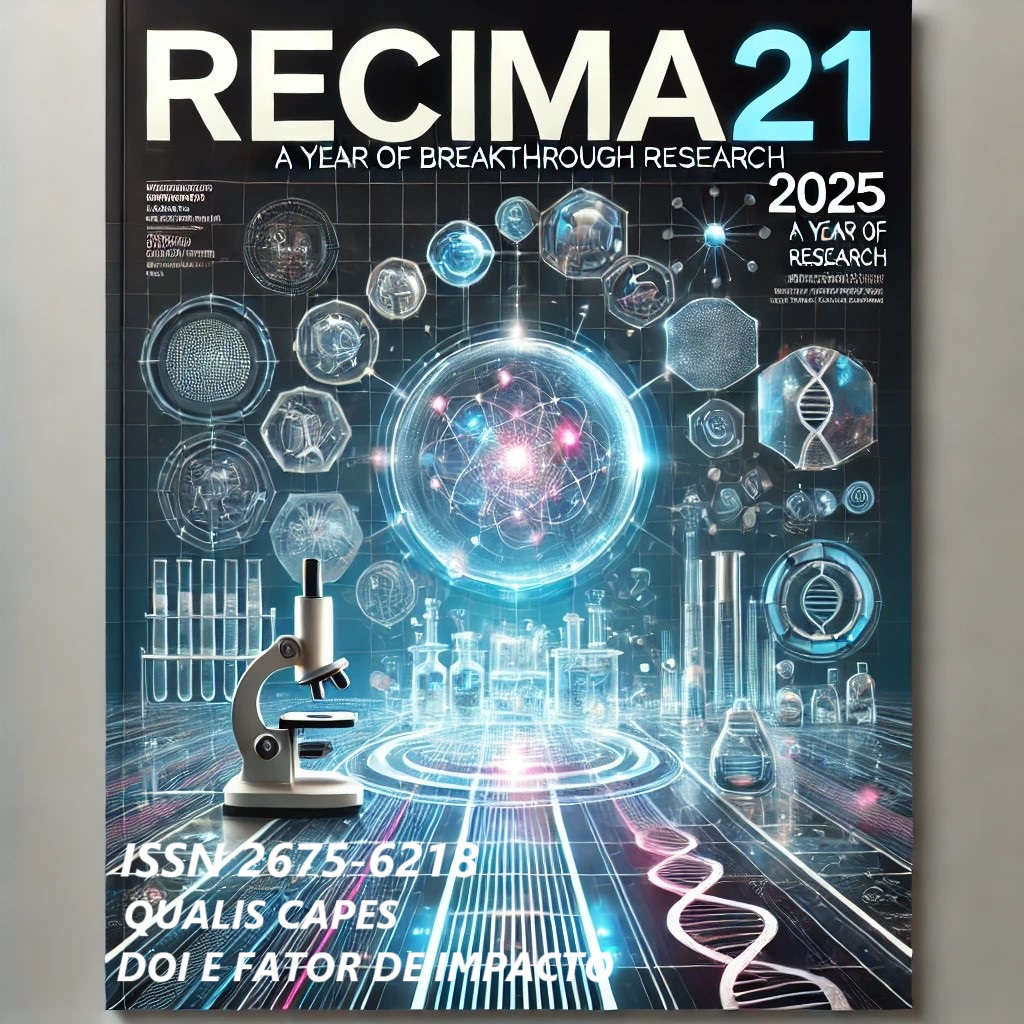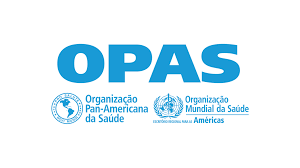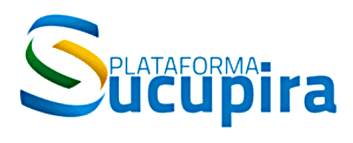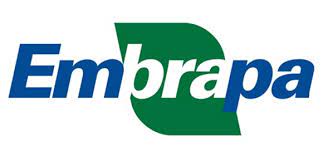ESTRATÉGIAS MORFOLÓGICAS E OCUPAÇÃO ECOLÓGICA DE BIVALVES EM COSTÕES ROCHOSOS DE ARRAIAL DO CABO-RJ
DOI:
https://doi.org/10.47820/recima21.v6i10.6864Palavras-chave:
, bioinvasão, Ecologia de bivalves, , Morfometria multivariadaResumo
A morfologia de bivalves em ambientes costeiros é modulada por gradientes ambientais e pressões ecológicas, refletindo adaptações funcionais e processos de exclusão competitiva. Este estudo analisou a variação morfológica de três espécies, Pinctada imbricata, Perna perna e Isognomon bicolor, em costões rochosos de Arraial do Cabo (RJ), submetidos a diferentes níveis de hidrodinamismo e intensidade da ressurgência. Foram coletados 50 indivíduos por espécie em quatro localidades com distintas exposições, e avaliadas 18 variáveis morfométricas por meio de análises multivariadas (ACP e análise discriminante), com correção alométrica para isolar os efeitos da forma. Os resultados revelaram que I. bicolor e P. perna apresentaram variação predominantemente associada ao tamanho, enquanto P. imbricata apresentou diferenciação mais vinculada à forma da concha. A segregação morfológica entre localidades reflete respostas adaptativas às condições locais, sendo mais intensa em espécies com menor tolerância ao estresse físico. A ocupação diferencial por espécies nativas e exóticas indica processos ativos de bioinvasão e substituição ecológica. Conclui-se que a morfometria funcional, associada a gradientes ambientais, constitui ferramenta sensível para detectar padrões adaptativos, com implicações relevantes para o monitoramento de comunidades costeiras e para estratégias de conservação diante da expansão de espécies invasoras.
Downloads
Referências
ALBUQUERQUE, A. L. S.; BELEM, A. L.; ZULUAGA, F. J. B.; CORDEIRO, L. G. M.; MENDOZA, U.; KNOPPERS, B. A.; GURGEL, M. H. C.; MEYERS, P. A.; CAPILLA, R. Particle fluxes and bulk geochemical characterization of the Cabo Frio upwelling system in Southeastern Brazil: sediment trap experiments between spring 2010 and summer 2012. Anais da Academia Brasileira de Ciências, v. 86, p. 601–620, 2014. DOI: https://doi.org/10.1590/0001-37652014107212
BELEM, A. L.; CASTELAO, R. M.; ALBUQUERQUE, A. L. Controls of subsurface temperature variability in a western boundary upwelling system. Geophysical Research Letters, v. 40, n. 7, p. 1362–1366, 2013. DOI: https://doi.org/10.1002/grl.50297
BELTRÃO, M. C.; DA CUNHA, N. J. R.; DE OLIVEIRA LAAF, Y.; DIEHL, F. L.; DOS SANTOS, T. D. Molecular methods confirm the first report of the non-indigenous Perna viridis Linnaeus, 1758 (Mytilida, Mytilidae) in southern Brazil. Check List, v. 20, n. 4, p. 859–867, 2024. DOI: https://doi.org/10.15560/20.4.859
BREVES-RAMOS, A.; JUNQUEIRA, A. O. R.; LAVRADO, H. P.; SILVA, S. H. G.; FERREIRA-SILVA, M. A. G. Population structure of the invasive bivalve Isognomon bicolor on rocky shores of Rio de Janeiro State (Brazil). Journal of the Marine Biological Association of the United Kingdom, v. 90, n. 3, p. 453–459, 2010. DOI: https://doi.org/10.1017/S0025315409990919
BUMBEER, J.; ROCHA, R. M. da. Invading the natural marine substrates: a case study with invertebrates in South Brazil. Zoologia (Curitiba), v. 33, n. 03, e20150211, 2016. DOI: https://doi.org/10.1590/S1984-4689zool-20150211
CONNELL, S. D. Assembly and maintenance of subtidal habitat heterogeneity: synergistic effects of light penetration and sedimentation. Marine Ecology Progress Series, v. 289, p. 53–61, 2016. DOI: https://doi.org/10.3354/meps289053
CORRÊA, T. R.; CALDERON, E.; DA SILVA LIMA, L.; DE FREITAS DELGADO, J.; NETO, J. A. B.; DE CARVALHO AGUIAR, V. M.; DA FONSECO, E. M. Bioinvasion of benthic invertebrates in a eutrophicated tropical estuarine system in South America (Santos, Brazil). Environmental Protection Research, p. 38–55, 2023. DOI: https://doi.org/10.37256/epr.3120231656
CREED, J. C.; FENNER, D.; SAMMARCO, P.; CAIRNS, S.; CAPEL, K.; JUNQUEIRA, A. O. R.; CRUZ, I.; MIRANDA, R. J.; CARLOS-JUNIOR, L.; MANTELATTO, M. C. The invasion of the azooxanthellate coral Tubastraea (Scleractinia: Dendrophylliidae) throughout the world: history, pathways and vectors. Biological Invasions, v. 19, n. 1, p. 283–305, 2017. DOI: https://doi.org/10.1007/s10530-016-1279-y
DANG, C.; SEVERN-ELLIS, A. A.; BAYER, P.; ANDERSON, N.; GHOLIPOUR-KANANI, H.; BATLEY, J.; MCCAULEY, R. D.; DAY, R. D.; SEMMENS, J. M.; SPEED, C.; MEEKAN, M. G.; PARSONS, M. J. G. Insights into the transcriptomic responses of silver-lipped pearl oysters Pinctada maxima exposed to a simulated large-scale seismic survey. BMC Genomics, v. 25, n. 1, 1188, 2024. https://doi.org/10.1186/s12864-024-11091-7 DOI: https://doi.org/10.1186/s12864-024-11091-7
DE OLIVEIRA, A. G. L.; VALLADARES, V.; SANTOS, C. P.; MELLO-SILVA, C. C. Near infrared spectroscopy: a method for the monitoring and management of the commercial exploitation of the brown mussel (Perna perna) in southeastern Brazil. Frontiers in Marine Science, v. 10, 08 june 2023. https://doi.org/10.3389/fmars.2023.1192024 DOI: https://doi.org/10.3389/fmars.2023.1192024
DE SOUZA FARIA, R. G.; CORRÊA LUZ DE SOUZA, R. C. Biodiversity of Marine Molluscs from Sambaqui da Tarioba, Rio das Ostras, Rio de Janeiro (Brazil). Revista Chilena de Antropología, v. 29, 2014.
DE SOUZA, R. C. C. L.; DA COSTA FERNANDES, F.; DA SILVA, E. P. A study on the occurrence of the brown mussel Perna perna on the sambaquis of the Brazilian coast. Revista Do Museu de Arqueologia e Etnologia, v. 13, p. 3–24, 2003. DOI: https://doi.org/10.11606/issn.2448-1750.revmae.2003.109462
DE SOUZA, R. C. C. L.; LIMA, T. A.; SILVA, E. P. Holocene molluscs from Rio de Janeiro state coast, Brazil. Check List, v. 6, n. 2, p. 301–308, 2010. DOI: https://doi.org/10.15560/6.2.301
DOMANESCHI, O.; MARTINS, C. M. Isognomon bicolor (CB Adams)(Bivalvia, Isognomonidae): primeiro registro para o Brasil, redescrição da espécie e considerações sobre a ocorrência e distribuição de Isognomon na costa brasileira. Revista Brasileira de Zoologia, v. 19, p. 611–627, 2010. DOI: https://doi.org/10.1590/S0101-81752002000200017
FERREIRA, Carlos Eduardo Leite; DE OLIVEIRA Ribeiro Junqueira. Marine Bioinvasions in the Brazilian Coast: Brief Report on History of Events, Vectors, Ecology, Impacts and Management of Non-indigenous Species. In: RILOV, J. A. (Ed.), Biological Invasions in Marine Ecosystems: Ecological, Management, and Geographic Perspectives. Berlin, Heidelberg: Springer, 2009. p. 459–477. https://doi.org/10.1007/978-3-540-79236-9_27 DOI: https://doi.org/10.1007/978-3-540-79236-9_27
GLASBY, T. M.; CONNELL, S. D.; HOLLOWAY, M. G.; HEWITT, C. L. Nonindigenous biota on artificial structures: could habitat creation facilitate biological invasions? Marine Biology, v. 151, n. 3, p. 887–895, 2007. DOI: https://doi.org/10.1007/s00227-006-0552-5
GOSLING, E. Marine bivalve molluscs. [S. l.]: John Wiley & Sons, 2007.
GRADEL, A.; BENESTAN, L.; LEGRAND, T.; LE LUYER, J.; PLANES, S.; REISSER, C. M. O. Combining population genomics, larval dispersal modelling and graph theory to reveal connectivity patterns of the black-lipped pearl oyster in French Polynesia. Scientific Reports, v. 15, n. 1, p. 24611, 2025. DOI: https://doi.org/10.1038/s41598-025-10113-y
GRANTHOM-COSTA, L. V.; MESSANO, L. V. R.; DE ALTVATER, L.; SPOTORNO, P.; COUTINHO, R. Non-native marine sessile benthic species from the coastal upwelling ecosystem of Arraial do Cabo, Brazil. Aquatic Invasions, v. 20, n. 2, p. 181–198, 2025. https://doi.org/10.3391/ai.2025.20.2.147751 DOI: https://doi.org/10.3391/ai.2025.20.2.147751
HENRIQUES, M. B.; CASARINI, L. M. Avaliação do crescimento do mexilhão Perna perna e da espécie invasora Isognomon bicolor em banco natural da Ilha das Palmas, Baía de Santos, estado de São Paulo, Brasil. Boletim Do Instituto de Pesca, v. 35, n. 4, p. 577–586, 2025.
HMIDA, L.; FASSATOUI, C.; MISSAOUI, S.; ZAGHAB, J.; ROMDHANE, M. S.; LE LOC’H, F.; BEN RAIS LASRAM, F. Morphological and genetic characterization of the invasive rayed pearl oyster Pinctada imbricata radiata (Mollusca: Bivalvia: Pteriidae) populations from contrasting environments along the Tunisian coast. Marine Biology Research, v. 17, n. 2, p. 200–214, 2021. DOI: https://doi.org/10.1080/17451000.2021.1919713
HUHN, M.; HATTICH, G. S. I.; ZAMANI, N. P.; VON JUTERZENKA, K.; LENZ, M. Tolerance to stress differs between Asian green mussels Perna viridis from the impacted Jakarta Bay and from natural habitats along the coast of West Java. Marine Pollution Bulletin, v. 110, n. 2, p. 757–766, 2016. DOI: https://doi.org/10.1016/j.marpolbul.2016.02.020
LEMER, S.; PLANES, S. Effects of habitat fragmentation on the genetic structure and connectivity of the black-lipped pearl oyster Pinctada margaritifera populations in French Polynesia. Marine Biology, v. 161, n. 9, p. 2035–2049, 2014. DOI: https://doi.org/10.1007/s00227-014-2484-9
LESSA, D. V. O.; VENANCIO, I. M.; DOS SANTOS, T. P.; BELEM, A. L.; TURCQ, B. J.; SIFEDDINE, A.; ALBUQUERQUE, A. L. S. Holocene oscillations of Southwest Atlantic shelf circulation based on planktonic foraminifera from an upwelling system (off Cabo Frio, Southeastern Brazil). The Holocene, v. 26, n. 8, p. 1175–1187, 2016a.
LESSA, D. V. O.; VENANCIO, I. M.; DOS SANTOS, T. P.; BELEM, A. L.; TURCQ, B. J.; SIFEDDINE, A.; ALBUQUERQUE, A. L. S. Holocene oscillations of Southwest Atlantic shelf circulation based on planktonic foraminifera from an upwelling system (off Cabo Frio, Southeastern Brazil). The Holocene, v. 26, n. 8, p. 1175–1187, 2016b. DOI: https://doi.org/10.1177/0959683616638433
LI, F.; LIU, J.; GAO, Z.; YANG, C.; SUN, L.; LIAO, Y.; DENG, Y. Transcriptomic analyses of Pinctada fucata martensii responses under stress of titanium dioxide nanoparticles. Frontiers in Marine Science, v. 11, 2024. https://doi.org/10.3389/fmars.2024.1462589 DOI: https://doi.org/10.3389/fmars.2024.1462589
LIMA, L. L. C.; PASSOS, F. D. Marine bioinvasions: bivalve molluscs introduced in northeast Brazil. Diversitas Journal, v. 6, n. 1, p. 507–526, 2021. DOI: https://doi.org/10.17648/diversitas-journal-v6i1-1684
LÓPEZ, M. S.; LAVRADO, H. P.; COUTINHO, R. Structure of intertidal sessile communities before and after the invasion of Isognomon bicolor (CB Adams, 1845)(Bivalvia, Isognomonidae) in southeastern Brazil. Aquatic Invasions, v. 9, n. 4, 2014. DOI: https://doi.org/10.3391/ai.2014.9.4.04
MACHADO, N.; RUFINO, D.; BARBARINO, E.; DUPONT, S.; ROMARIZ, A.; LAMEGO, F. Impacts of Ocean Acidification on Survival of the Brown Mussel (Perna perna) in Brazil. Journal of Shellfish Research, v. 44, n. 2, p. 231–242, 2014. DOI: https://doi.org/10.2983/035.044.0206
MIRANDA, R. J.; TAGLIAFICO, A.; KELAHER, B. P.; MARIANO-NETO, E.; BARROS, F. Impact of invasive corals Tubastrea spp. on native coral recruitment. Marine Ecology Progress Series, v. 605, p. 125–133, 2018. DOI: https://doi.org/10.3354/meps12731
MU, Q.; LI, Z.; LIU, M.; ZHAO, B.; YANG, Z.; BAO, Z.; HU, J.; LIU, P. The chromosome-level genome assembly and annotation of the silver-lipped pearl oyster, Pinctada maxima. Scientific Data, v. 12, n. 1, 1301, 2025. https://doi.org/10.1038/s41597-025-05607-3 DOI: https://doi.org/10.1038/s41597-025-05607-3
NATÁLIO, L. F.; CHERNIESKI, D.; TOMIDA, L.; CAPEL, K. C. C. Alien corals in a Brazilian seaport and perspectives for improving marine bioinvasion detection and management in commercial ports. Ocean & Coastal Management, v. 218, 106021, 2022. DOI: https://doi.org/10.1016/j.ocecoaman.2021.106021
NUNES, L. M. de S. Ecologia populacional do bivalve Isognomon bicolor (CB ADAMS, 1945) no litoral do semiárido brasileiro. [S. l.: s. n,], 2022.
PANINI, R. L. Caracterização morfológica, extração e identificação das proteínas do pé do mexilhão Perna perna responsáveis pela formação do bisso. [S. l.: s. n,], 2013.
PIERRI, B. S.; FOSSARI, T. D.; MAGALHÃES, A. R. M. O mexilhão Perna perna no Brasil: nativo ou exótico? Arquivo Brasileiro de Medicina Veterinária e Zootecnia, v. 68, p. 404–414, 2016. DOI: https://doi.org/10.1590/1678-4162-8534
SEABRA, R.; WETHEY, D. S.; SANTOS, A. M.; LIMA, F. P. Understanding complex biogeographic responses to climate change. Scientific Reports, v. 5, n. 1, 12930, 2015. https://doi.org/10.1038/srep12930 DOI: https://doi.org/10.1038/srep12930
SHIMABUKURO, M.; CARRERETTE, O.; GÜTH, A. Z.; BERGAMO, G.; SUMIDA, P. Y. G. Soft-Bottom Communities Along the SE Brazilian Continental Shelf. In: Oceanography, Biodiversity, Fisheries and Conservation of Brazilian Continental Shelf Habitats. [S. l.]: Springer, 2025. p. 67–86. DOI: https://doi.org/10.1007/978-3-031-88338-5_3
SOARES, M. O.; DE LIMA XAVIER, F. R.; DIAS, N. M.; DA SILVA, M. Q. M.; DE LIMA, J. P.; BARROSO, C. X.; VIEIRA, L. M.; PAIVA, S. V.; MATTHEWS-CASCON, H.; BEZERRA, L. E. A. Alien hotspot: Benthic marine species introduced in the Brazilian semiarid coast. Marine Pollution Bulletin, v. 174, 113250, 2022. DOI: https://doi.org/10.1016/j.marpolbul.2021.113250
SUPLICY, F. M.; MOLTSCHANIWSKYJ, N. Estimating growth using an ecophysiological and scope for growth model for the mussel Perna perna grown under suspended culture in Santa Catarina, Brazil. Regional Studies in Marine Science, v. 74, 103540, 2024. DOI: https://doi.org/10.1016/j.rsma.2024.103540
TELESCA, L.; MICHALEK, K.; SANDERS, T.; PECK, L. S.; THYRRING, J.; HARPER, E. M. Blue mussel shell shape plasticity and natural environments: a quantitative approach. Scientific Reports, v. 8, n. 1, 2865, 2018. DOI: https://doi.org/10.1038/s41598-018-20122-9
TOMANEK, L. Environmental Proteomics: Changes in the Proteome of Marine Organisms in Response to Environmental Stress, Pollutants, Infection, Symbiosis, and Development. Annual Review of Marine Science, v. 3, p. 373–399, 2011. https://doi.org/https://doi.org/10.1146/annurev-marine-120709-142729 DOI: https://doi.org/10.1146/annurev-marine-120709-142729
ÜNLÜ, A. G.; TERLAU, J. F.; BUCHER, R. Predation and avoidance behavior of the pea aphid Acyrthosiphon pisum confronted with native and invasive lady beetles in Europe. Biological Invasions, v. 22, n. 5, p. 1647–1656, 2020. DOI: https://doi.org/10.1007/s10530-020-02209-5
VALENTIN, J. L. The cabo frio upwelling system, Brazil. In: Coastal marine ecosystems of Latin America. [S. l.]: Springer, 2001. p. 97–105 DOI: https://doi.org/10.1007/978-3-662-04482-7_8
VENANCIO, I. M.; GOMES, V. P.; BELEM, A. L.; ALBUQUERQUE, A. L. S. Surface-to-subsurface temperature variations during the last century in a western boundary upwelling system (Southeastern, Brazil). Continental Shelf Research, v. 125, p. 97–106, 2016. DOI: https://doi.org/10.1016/j.csr.2016.07.003
Downloads
Publicado
Licença
Copyright (c) 2025 RECIMA21 - Revista Científica Multidisciplinar - ISSN 2675-6218

Este trabalho está licenciado sob uma licença Creative Commons Attribution 4.0 International License.
Os direitos autorais dos artigos/resenhas/TCCs publicados pertecem à revista RECIMA21, e seguem o padrão Creative Commons (CC BY 4.0), permitindo a cópia ou reprodução, desde que cite a fonte e respeite os direitos dos autores e contenham menção aos mesmos nos créditos. Toda e qualquer obra publicada na revista, seu conteúdo é de responsabilidade dos autores, cabendo a RECIMA21 apenas ser o veículo de divulgação, seguindo os padrões nacionais e internacionais de publicação.













